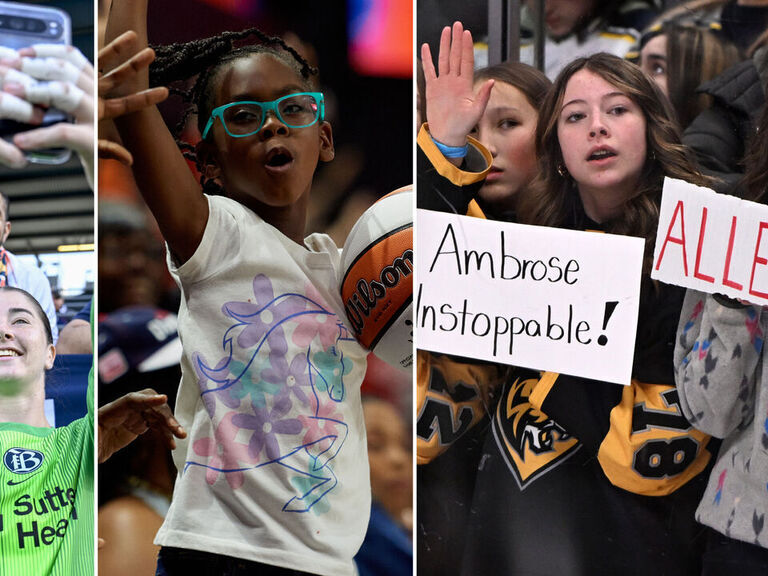The crowd roars as Hannah Miller breaks away from the defender, dekes right, then swipes the puck into the net. The 5,067 fans at Ottawa’s TD Place explode in celebration, their cheers reverberating through the arena.
It’s a scene that would have seemed unlikely just a few years ago—thousands of people paying good money to watch women play hockey on a weeknight. But this is the new reality for the Professional Women’s Hockey League (PWHL), which has shattered attendance expectations since launching in January 2024.
“I’ve never experienced anything like this,” says Michelle Carter, a 42-year-old accountant who drove two hours with her daughter to attend the game. “Growing up, women’s sports were barely on TV. Now we’re buying season tickets and merchandise. My daughter sees these players as her heroes.”
This transformation isn’t isolated to hockey. Across North America, women’s sports are experiencing unprecedented growth in viewership, attendance, and cultural relevance. The WNBA recently announced its highest regular season attendance since 2018. The National Women’s Soccer League set new attendance records, averaging over 10,000 fans per game in 2023, a 31% increase from the previous year according to Sports Business Journal.
What’s driving this surge? The answer involves changing demographics, digital culture, and a fundamental shift in how fans engage with sports.
When I visited Toronto’s Mattamy Athletic Centre for a PWHL game in February, I noticed something striking about the crowd—it wasn’t the stereotypical sports audience. Families with young children sat alongside groups of twenty-something professionals. The demographic was noticeably diverse, with roughly equal numbers of men and women.
“Women’s sports attract a different kind of fan,” explains Dr. Sarah Jenkins, who studies sports sociology at the University of British Columbia. “These are often people who value the community aspect of fandom as much as the competition itself. They’re creating spaces that feel more inclusive and less dominated by traditional sports culture.”
This community-first approach is evident in how fans interact. At PWHL games, you’ll see more selfies with players, homemade signs, and multi-generational groups than at many men’s professional games. After matches, players regularly spend time signing autographs and chatting with young fans—something increasingly rare in men’s elite sports.
Digital platforms have accelerated this connection. The PWHL has amassed over 175,000 followers on Instagram in just months, with players building personal brands through authentic, unfiltered content. Toronto PWHL forward Sarah Nurse boasts over 250,000 followers, offering glimpses into both her athletic career and personal life.
“Social media allows for direct athlete-to-fan relationships that bypass traditional gatekeepers,” notes Meaghan Hughes, digital strategy director at SportsPulse Media. “Women athletes tend to be particularly effective at this kind of community building because they’ve had to be. Without the same media coverage as men’s sports, they’ve learned to tell their own stories.”
The economic impact is becoming impossible to ignore. Merchandise for PWHL teams frequently sells out, with jerseys and team-branded apparel flying off shelves. The league’s broadcast deal with CBC Sports and TSN in Canada and ESPN in the United States has brought games to millions of viewers. Major brands including Canadian Tire, Scotiabank, and Bauer have signed on as sponsors, recognizing the valuable demographic these leagues attract.
“We’re seeing a virtuous cycle,” explains financial analyst Jordan Thompson, who specializes in sports economics. “As viewership grows, investment increases, which improves product quality, which attracts more fans and bigger sponsors. Women’s sports are no longer seen as charity cases—they’re legitimate business opportunities.”
The accessibility of players has created a different relationship between athletes and fans. When PWHL Minnesota captain Kendall Coyne Schofield stayed after a recent game to meet every single fan waiting in line—in sub-zero temperatures—it reinforced the connection that makes women’s sports distinctive.
“These athletes remember what it was like to have no one watching,” says Emily Wilson, whose podcast covers women’s hockey. “They’re building the plane while flying it, and they understand their responsibility as ambassadors.”
This phenomenon extends beyond hockey. Angel City FC of the National Women’s Soccer League has revolutionized the ownership model, with a community-oriented approach that includes fans and local businesses in decision-making. Their average attendance of over 19,000 per match rivals many men’s professional teams.
The WNBA’s 2023 finals between the Las Vegas Aces and New York Liberty drew the league’s highest viewership in 20 years, according to ESPN data. The championship-clinching game averaged 889,000 viewers—a 36% increase from 2022.
Not everyone is convinced the trend will continue. Skeptics point to previous waves of interest in women’s sports that failed to sustain momentum. Others note the still-significant gap between top men’s and women’s leagues in terms of revenue and media coverage.
But what feels different this time is the cultural context. Today’s fans, particularly younger ones, increasingly reject the notion that men’s sports are inherently more exciting or worthy of attention.
“My sons prefer watching PWHL games because they can actually meet the players afterward,” says Thomas Wright, who brought his 9 and 11-year-old boys to Ottawa’s game against Montreal. “They don’t care about gender—they care about connection.”
The rising tide appears to be lifting multiple sports simultaneously. Cross-promotion between leagues has become common, with WNBA stars attending NWSL games and vice versa. This solidarity creates a larger ecosystem where fans of one women’s sport often become fans of others.
As I leave TD Place after watching Ottawa defeat Montreal in overtime, I notice families lingering, children clutching newly purchased jerseys, and adults discussing plans to return for the next game. What’s unfolding isn’t just a business story—it’s a cultural shift in how we define sports fandom itself.
For generations raised watching women compete at the highest levels, the question isn’t whether women’s sports will continue growing, but how quickly the rest of the sports industry will adapt to this new reality.






